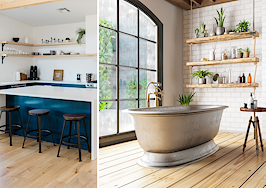Purchasing a home involves more than just finding a house that fits a buyer’s budget and preferences. For many buyers, a home’s architectural style is a crucial factor that makes or breaks a purchasing decision.
As a real estate agent, it’s essential to understand a client’s tastes, historical context and regional influences. Doing so ensures buyers are successfully matched with the right home in a style that suits their aesthetic preferences and lifestyle.
How Realtors match buyers with architectural styles
As with any art, matching buyers with architectural styles is a skill typically honed with experience. For Realtors, it takes a fair amount of practice to learn how to read people — whether buyers or sellers — and build knowledge of architectural styles and their history.
Here are some guidelines agents use to match buyers with architectural styles:
Understand the client
Before matching a buyer with their preferred architectural styles, Realtors must first understand their client’s unique preferences and lifestyle. Everyone has a version of their dream home, influenced by personal taste, cultural background and lifestyle choices. Recognizing these preferences makes it much easier to tailor a search to specific architectural styles that align with the client’s vision.
Every client is different. Some may prefer the timeless elegance of a Colonial-style residence, while others may be drawn to a modern home’s sleek, minimalist design. Younger generations may choose to invest in hybrid homes, a family with children may prioritize a home with spacious interiors and a secure backyard, and a professional couple may prefer a contemporary, low-maintenance dwelling.
A combination of active listening, empathy, thorough needs assessment, and leveraging technology is employed to achieve this understanding. Open and honest conversations help uncover unique insights into the client’s desires, priorities and potential concerns, while empathy helps build a stronger connection with them.
Agents create a comprehensive needs assessment by asking probing questions and encouraging clients to express their expectations openly. This can encompass everything from family size to preferred neighborhoods and lifestyle preferences.
Additionally, real estate agents today leverage technology tools, customer relationship management (CRM) systems and data analysis to improve their understanding of clients. This allows for personalized recommendations based on preferences, previous interactions and market trends.
Consider historical context and regional influences
Architectural styles have significant historical and regional influences. Skilled agents understand the importance of guiding clients on a journey of exploration. Knowing how to highlight the historical context of various architectural styles prevalent in the area while ensuring a more personalized, meaningful purchasing experience is key.
A buyer in New England might be drawn to a Cape Cod-style home that originated in the 17th century and reflects the region’s colonial heritage. On the other hand, a client in the southwestern U.S. might prefer the more Spanish style that so many properties in the region are characterized by.
Educating buyers about the historical background of architectural styles enhances their appreciation for the homes they’re considering. Additionally, it helps them make informed decisions that reflect the community’s cultural fabric.
Exploring the history of a property’s architecture provides insights into its durability, potential maintenance challenges and overall functionality. This ensures the home aligns with the buyer’s visual preferences and meets practical needs for comfortable living. It also helps buyers to make more informed decisions, avoiding surprises or inconveniences associated with specific architectural styles.
Balance aesthetics with functionality
A harmonious and satisfying homeownership experience requires the balancing of aesthetics and functionality with a buyer’s needs and preferences. Aesthetics play an important role in creating an emotional appeal for a property, resonating with the buyer’s sense of style. However, aesthetics alone cannot guarantee practical suitability for daily living.
Functionality addresses the practical aspects of a home, such as layout, space utilization and amenities. These are crucial for accommodating the buyer’s lifestyle, family dynamics and long-term goals. A well-balanced approach considers the visual appeal and functionality that align with the buyer’s daily activities and aspirations.
Neglecting functionality in favor of aesthetics or vice versa can lead to dissatisfaction and potential challenges. For example, an aesthetically pleasing home that lacks functionality may result in discomfort, inconvenience and additional expenses for modifications. Conversely, a highly functional but visually unappealing space may fail to evoke an emotional connection to the home.
Therefore, by balancing aesthetics and functionality, agents ensure the properties they recommend look good. At the same time, the home aligns seamlessly with a client’s practical needs and personal preferences.
Navigate trends and timelessness
Navigating trends and timelessness is a delicate balance when matching a buyer to a property. While trends can provide a contemporary allure, recognizing the enduring value of timeless architectural elements is important, too. It’s, therefore, crucial to stay attuned to design cycles but still guides buyers toward architectural choices offering current appeal and long-term relevance.
Encouraging buyers to focus on timeless features ensures the property maintains its value and aesthetic charm. Classic design principles, quality construction and functional layouts transcend transient trends.
Simultaneously, acknowledging current trends allows Realtors to introduce modern options that align with buyers’ preferences. Striking a balance between the two involves showcasing properties that integrate timeless fundamentals while incorporating subtle nods to contemporary design. Moreover, emphasizing a property’s adaptability to evolving trends will ensure that it can accommodate future modifications if desired.
Agents empower buyers by facilitating discussions about the intersection of trends and timelessness. They help them make informed decisions that resonate with their current tastes and the enduring appeal of a property, creating a harmonious and forward-looking investment.
An essential art that takes practice
For Realtors, matching buyers with architectural styles is about more than just facilitating property transactions. It requires becoming a storyteller, weaving narratives that connect clients with their potential homes’ history, culture and functionality.
To achieve this, agents must understand the unique preferences of each buyer, delve into the historical and regional context, balance aesthetics with functionality and navigate changing design trends.
Ultimately, the ideal is to create a harmonious connection between people and the spaces they inhabit. This connection goes beyond the physical structure of a home as it resonates with the essence of what “home” means to each buyer.
By mastering this art, real estate agents become more than just sellers of properties; they help to realize dreams, too.
Michelle Coffing is the managing broker at Ruby Home, a luxury real estate brokerage. Connect with her on Linkedin.













